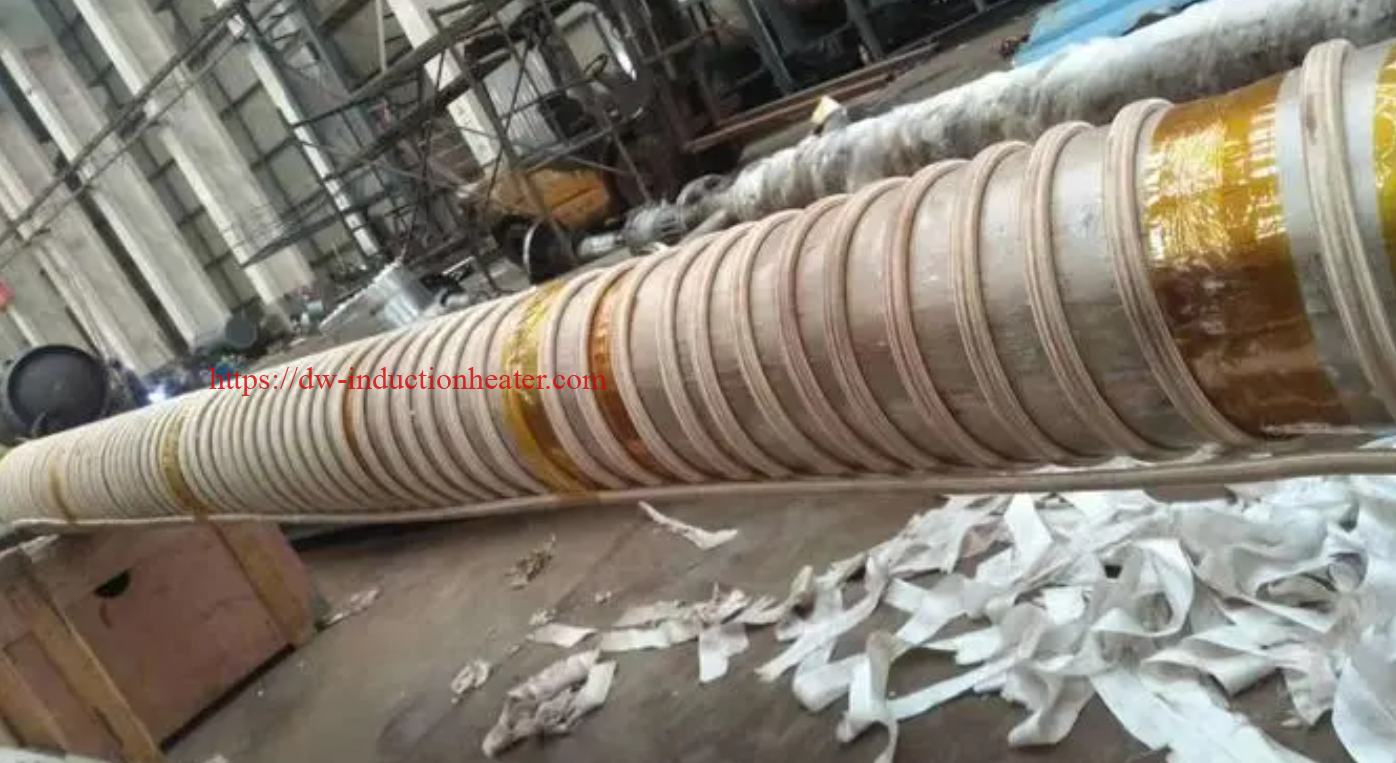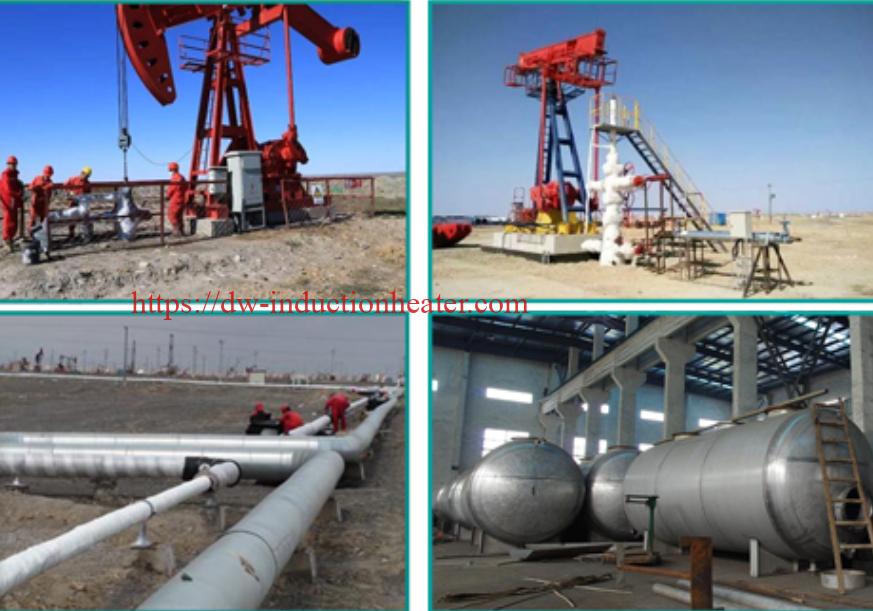
Induction Oil Gas Heating Pipelines System
In the oil and gas industry, the transportation of crude oil and gas requires pipelines that are well-maintained and heated efficiently to prevent any unwanted incidents. Traditional methods of heating pipelines such as direct flame and electrical heating are inefficient and have several limitations. In recent years, induction heating technology has emerged as a promising solution for heating pipelines, providing a more efficient and reliable alternative.
Induction heating is based on electromagnetic principles where an alternating current is passed through a coil, and the magnetic field produced by the current generates heat in the object that is placed inside the coil. This process heats the object uniformly, without any contact between the heating element and the object. In the case of oil and gas pipelines, the induction heating system generates an alternating current that is passed through the coil wrapped around the pipeline, providing a uniform heating effect on the entire length of the pipeline.
Induction heating technology for oil and gas pipelines has several advantages over conventional heating methods. Firstly, it provides uniform heating along the entire length of the pipeline, eliminating any cold spots that may occur when using direct flame heating. Secondly, it is very energy-efficient as it consumes only the energy required to heat the pipeline, unlike direct flame heating, which is highly inefficient and consumes a lot of energy. Thirdly, induction heating is highly reliable, as it is resistant to power fluctuations and can operate in harsh environmental conditions.
Induction heating technology is also highly versatile, as it can be used for different pipeline materials such as steel, aluminum, and copper, among others. It can also be used for various pipeline diameters and lengths, depending on the specific needs of the application.
As with any technology, there are some limitations of
induction heating for oil and gas pipelines. The initial installation cost of the system can be relatively high compared to traditional heating methods. However, in the long run, it can lead to significant cost savings due to its energy efficiency and reliability. Induction heating also requires a trained operator with the necessary skills to ensure the system's safe operation.

What Is Induction Oil Gas Heating?
If you work with pipelines, you know that keeping the oil and gas inside them at the right temperature is a must. That's why induction oil gas heating is the way of the future. It's a revolutionary technology that heat pipelines quickly, evenly, and reliably.
So how does it work? Put simply, induction heating uses electricity or magnetic energy to create heat in an object—in this case, pipes that need to be heated. By cycling electrical current through an induction coil placed around the pipe, an alternating magnetic field is created. This induces a measurable and reliable amount of heat energy in the pipe itself.
The great thing about induction is that it eliminates any issues associated with traditional heating methods—like hot spots or localized burning. Plus, it's highly efficient and require no combustion which helps promote sustainability for businesses working with pipelines today.
How Does Induction Oil Gas Heating Work?
Induction oil gas heating is a form of pipeline heating that is revolutionizing the energy sector. But what exactly is it? How does it work?
In essence, induction oil gas heating uses electrical current to generate heat in pipelines. This type of heating works by inducing a current in the pipe that heats both the pipe itself and the oil traveling through it. By using an alternating electric current, heat is generated through electromagnetic induction, as opposed to resistive or convective processes that are used in traditional pipeline heating.
In addition to being faster and more efficient than traditional methods, induction oil gas heating also offers many safety advantages. As the electrical current never comes into contact with the pipeline itself, there's no risk of sparking or fire—making it ideal for pipelines carrying flammable products. Furthermore, this method eliminates potential damage from corrosion and other environmental factors that can be caused by resistive or convective heating methods.

Benefits of Using Induction Oil Gas Heating
When you switch to induction oil gas heating, there are plenty of benefits that make the process faster, safer, and more efficient. Here's what you should keep in mind.
Speed
Induction heating is much faster than traditional methods. You can heat long pipeline sections in minutes rather than hours to get the job done quickly and efficiently. That means you can save time and money on the job, making it ideal for pipeline construction projects.
Safety
Since induction oil gas heating uses electric currents rather than air-fuel flames, it eliminates the risk of fire or explosions, which makes it much safer. Plus, because it doesn't require open flames like other methods do, you don't have to worry about toxic fumes or other dangerous airborne particles—all you need is electricity to get the job done right.
Reliability
Induction heating is reliable and consistent; the temperature of an entire section can be accurately controlled and monitored remotely with effective temperature control systems. Added bonuses? The heated area will cool down quickly after the power is turned off because there are no exhaust gasses or coolants involved—good news for those tight deadlines!
Installation Considerations for an Induction Oil Heating System
If you're considering installing an
induction oil heating system, there are a few factors to take into account. For starters, you need to make sure that the pipeline is of adequate length to accommodate an induction coil for the length of pipe that needs to be heated. The rest of the components should be installed in a dry, clean environment that is free from dust and debris.
Here are some other guidelines to keep in mind:
- Match the coil's electrical specifications with your pipeline's size and material
- Make sure that you follow all local laws and regulations when it comes to electrical installation
- Ensure sufficient ventilation, as oil overheating can become dangerous
- Use appropriate electrical wiring and grounding techniques
- Check for any unseen obstructions along the pipe such as rocks or dirt before installing your induction coil
- If possible, use insulation materials around the coils and pipes to minimize heat loss
As long as these considerations are taken into account when planning for installation, an induction oil heating system can prove to be a reliable way of heating large sections of pipelines quickly, effectively and efficiently—revolutionizing pipelines all over the world!

Common Applications of Induction Oil Gas Heating
Induction oil gas heating is the latest technology when it comes to pipeline construction. It's a surprisingly versatile form of heat, and it can be used in a variety of applications, from commercial to residential. Here are some common applications:
Underground pipelines
Induction heating can be used on underground pipelines for geothermal and sewage systems, where it's especially effective for even heat distribution and efficient delivery of oil. It also reduces installation time, meaning you get your geothermal or waste water system up and running quicker.
Pre-insulated pipes
Induction heating is also great for pre-insulated pipes that need protection from external temperature variations. This means your pipes will stay warm without having to use extra energy, saving you on utility bills over time.
Refineries
And of course, induction oil gas heating is often used in refineries, where it's applied as coating material preparation processes or other steel components that require high temperatures. It's an effective process since there are no open flames involved while things are being heated up!
No matter the application, induction oil gas heating offers a modern and efficient way to get pipelines working quickly and safely—all without compromising on quality or cost.
Advantages and Disadvantages of an Induction Oil Heating Pipeline
You may not know that induction oil gas heating offers several advantages over traditional methods of heating. It is faster, much more efficient and requires less energy than other forms of heating, making it an attractive option for many industrial operations.
Advantages
One of the key advantages of induction pipe heating is that it requires fewer resources to heat a pipeline. This is because the heat generated by the induction coil is transferred directly to the pipeline, rather than through air or another medium, meaning less energy is lost in the process. Additionally, it can be done remotely with no need for contact with hazardous materials.
Disadvantages
The main downside to induction pipe heating is that it can require expensive equipment and infrastructure in order to perform optimally. In addition, its effectiveness depends largely on the type of material being heated and its thickness — if a material's insulation does not allow for enough heat transfer, then it may not be suitable for induction pipe heating. Finally, it can take longer than other methods of heating large areas of pipelines at once.
Conclusion
In short,
induction oil gas heating is revolutionizing pipelines and changing the way we move oil and gas around the world. Not only is it more cost-effective, efficient, and safer than traditional oil and gas transportation methods, it is also more environmentally friendly, sources more sustainable energy sources, and reduces emissions. With so many advantages, it's no wonder induction oil gas heating is quickly gaining traction in the industry.
It's clear that induction oil gas heating is the way of the future and will continue to play a major role in oil and gas transportation for many years to come. By taking advantage of this technology now, companies can not only reduce costs, but also increase safety, sustainability, and efficiency. This is a win-win for everyone involved—companies, consumers, and the environment.
https://dw-inductionheater.com/induction-oil-gas-heating-pipelines.html?feed_id=207736&_unique_id=646f45ee902bd




